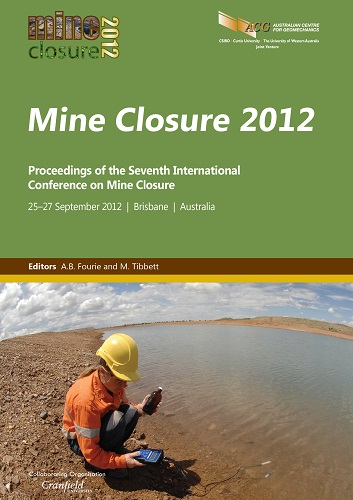Overburden stockpile revegetation techniques at PT Freeport Indonesia Grasberg Mine

|
Authors: Prewitt, JM; Puradyatmika, P |
DOI https://doi.org/10.36487/ACG_rep/1208_43_Prewitt
Cite As:
Prewitt, JM & Puradyatmika, P 2012, 'Overburden stockpile revegetation techniques at PT Freeport Indonesia Grasberg Mine', in AB Fourie & M Tibbett (eds), Mine Closure 2012: Proceedings of the Seventh International Conference on Mine Closure, Australian Centre for Geomechanics, Perth, pp. 493-505, https://doi.org/10.36487/ACG_rep/1208_43_Prewitt
Abstract:
PT Freeport Indonesia (PTFI) operates the Grasberg open pit mine in the Indonesian province of Papua producing copper and gold concentrate. The Grasberg pit began operation in 1989 and is currently planned to transition to an underground operation in 2017. By the time of the transition to underground operations, over three billion tonnes of overburden will have been placed in the overburden stockpiles surrounding the open pit. This paper briefly describes the layout of the stockpiles and processes in place to ensure geotechnical and geochemical stability of the stockpiles, but focuses on revegetation techniques for reclamation. PTFI practices concurrent reclamation of overburden stockpiles as areas reach final configuration and has already reclaimed over 260 hectares of land surface area using native plants suitable to the alpine location. Reclamation plans, techniques and costs are covered by Five Year Reclamation Plans that are submitted to the government of Indonesia for approval. Progress is verified annually by Ministry of Energy and Mineral Resources (MEMR) inspectors. Successful completion of the planned revegetation is required to release the funds set aside based on the Five Year Reclamation Plans. Plants, seeds and mosses are harvested from surrounding areas and prepared in a nursery operated at the mining area. A tissue culture technique to produce additional seeds and seedlings is also being trialled at Grasberg and is the subject of a separate paper at this conference. Transplanted plants and seedlings are allowed to acclimate to the alpine climate conditions in the nursery before being planted on the overburden stockpiles. A combination of organic compost, both produced onsite and purchased from offsite, and commercially available fertilisers are used to promote the plant growth. Soil availability is severely limited at the mine elevation and a limestone fines material is used as a soil substitute to allow placement of the plants, especially on the slopes. Overburden slopes are designed at 2H:1V overall with slope faces generally at angle of repose interspersed with flat benches. Transplanting on the slopes requires special techniques and training of personnel to ensure personnel safety as well as viability of the vegetation. In addition to transplanting, hydroseeding is used to assist in full vegetative coverage. Monitoring of reclamation areas includes soil sampling, evaluation of erosion, plant viability surveys, and evaluation of biodiversity of flora and fauna. The biodiversity of reclaimed areas is compared to adjacent non-disturbed areas. Monitoring techniques used as well as some typical results are shown in the paper.
References:
Beak Pacific Inc. (1996) Report No. 7A: Review of Vegetation for Reclamation Uses at High Elevation Minesites, Beak Pacific Inc., Vancouver, BC, Canada.
Golder Associates Inc. (1997) Preliminary Plan for the Reclamation of Mine Overburden and Mill Tailings at PT Freeport Indonesia Company Operations, Irian Jaya, July 1997, Golder Associates Inc., Lakewood, CO, USA.
Hope, G.S. (1976) The Equatorial Glaciers of New Guinea: Results of the 1971–1973 Australian Universities' Expeditions to Irian Jaya: Survey, Glaciology, Meterology, Biology and Palaeoenvironments, J. A. Peterson, U. Radok and I. Allison (eds), A.A. Balkema, Rotterdam.
Hort Research (2001) Developing Protocols for Utilising Moss in Revegetation of the Grasberg Overburden, Hort Research, Motueka, NZ.
Johns, R.J. and Hidayata, A. (1999) Report on the Species Trials on Consolidated Overburden at Carstenz Meadow, The Royal Botanical Gardens, Richmond, Surrey, UK.
Kew Royal Botanical Gardens (2000) A Preliminary Checklist of the Alpine and Subalpine Flora of Puncak Jaya, The Royal Botanical Gardens, Richmond, Surrey, UK.
Miller, H.A. (1991a) Development of a Reclamation Plan for the Carstenszweide Overburden, Lotspiech and Associates Inc., Winter Park, Florida, USA.
Miller, H.A. (1991b) A Botanical Study of the Carstenz Meadow and Other Meadows in the Area Irain Haya, Lotspiech and Associates Inc., Winter Park, Florida, USA.
PT Freeport Indonesia (1998) PTFI 300K Expansion Final Regional ANDAL, PT Freeport Indonesia, Jakarta, Indonesia.
PT Hatfindo and PT Freeport Indonesia (1997–1998) Biodiversity Surveys in the PT Freeport Indonesia Contract of Work Mining and Project Area, Mimika Regency, Irian Jaya, Indonesia, PT Freeport Indonesia, Environmental Department, Jakarta, Indonesia.
PT Hatfindo Prima (2001) Biodiversity and Ecophysiology of Rhododendrons for Overburden Restoration, PT Hatfindo Prima, Bogor, Indonesia.
Raytheon Employees Wildlife Habitat Committee (1999–2000), Biodiversity Measures, viewed 26 June 2012, .
Shea, G., Sarosa, W. and Uamang, P. (2006) Knowing our Mine Environment, Ethnobotany of Subalpine and Alpine Plants on Mt Jaya, PT Freeport Indonesia, Jakarta, Indonesia.
© Copyright 2025, Australian Centre for Geomechanics (ACG), The University of Western Australia. All rights reserved.
View copyright/legal information
Please direct any queries or error reports to repository-acg@uwa.edu.au
View copyright/legal information
Please direct any queries or error reports to repository-acg@uwa.edu.au